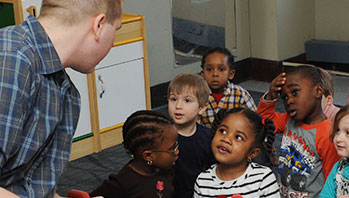- box full of previously collected seeds
- plant
- seed
MA Standards:
Speaking and Listening/SL.PK.MA.1: Participate in collaborative conversations with diverse partners during daily routines and play.
Language/L.PK.MA.6: Use words and phrases acquired through conversations, listening to books read aloud, activities, and play.
Mathematics/Measurement and Data/PK.MD.MA.1: Recognize the attributes of length, area, weight, and capacity of everyday objects using appropriate vocabulary (e.g., long, short, tall heavy, lights, big, small, wide, narrow).
MA Draft STE Standards:
Life Sciences/From Molecules to Organisms: Inheritance and Variation of Traits/LS1/3.A: Describe/draw and compare the body parts of animals (including themselves) and plants they are investigating [System] and explain functions of some of the observable body parts. [Structure and Function]
Life Sciences/From Molecules to Organisms: Inheritance and Variation of Traits/LS1/3.C: Use their sense in their exploration and play to gather information. [Structure and Function]
Head Start Outcomes:
Language Development/Receptive Language: Attends to language during conversations, songs, stories, or other learning experiences.
Language Development/Expressive Language: Uses language to express ideas and needs.
Logic and Reasoning/Reasoning and Problem Solving: Classifies, compares, and contrasts objects, events, and experiences.
PreK Learning Guidelines:
English Language Arts/Language 2: Participate actively in discussions, listen to the ideas of others, and ask and answer relevant questions.
Mathematics/Measurement 14: Use nonstandard units to measure length, weight, and amount of content in familiar objects.
Science and Technology/Life Sciences 10: Observe and identify the characteristics and needs of living things: humans, animals, and plants.
Science and Technology/Living Things and Their Environment 15: Use their senses of sight, hearing, touch, smell, and taste to explore their environment using sensory vocabulary.
Talk Together: Seeds Travel

© Commonwealth of Massachusetts, Department of Early Education and Care (Jennifer Waddell photographer). All rights reserved.
STEM Key Concepts: Many foods that animals, including humans, eat come from plants; We eat certain leaves, roots, fruits, and seeds; Fruits have seeds; Seeds hold what a plant needs to make more of itself; People and other animals interact with their environment through their senses
ELA Focus Skills: Compare and Contrast, Listening and Speaking, Vocabulary
Educator Prep: Before the activity begins, collect seeds from outdoor plants.
Safety Tips:
- Remind children to wash their hands before and after the activity.
- Children’s dietary needs have to be taken into account before introducing them to any food items.
Review with children the different ways seeds travel from one place to another. Talk about plants that have seeds and about the plants the children have been observing. Hold up a seed and ask children to describe it. Encourage children to use words to describe the way it feels, looks, its size and weight, etc. Then hold up another seed and have children describe it. Ask, Do you think these two seeds will travel from one place to another in the same way or in different ways? Why do you think that?
After children respond, demonstrate by holding up the dandelion seed and blowing on it and watching it float through the air. Then do the same with the pea and watch it fall to the floor. Ask,
- Why do you think the dandelion seed floated through the air and the pea seed fell to the ground?
- How do you think the pea seed will travel?
- If you have other seed samples, have children predict and demonstrate whether they float through the air or fall to the ground.
